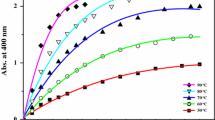Abstract
We report the antibacterial efficacies of silver and/or silver chloride containing titania xerogels synthesized with modified single step sol-gel methods against Escherichia coli bacteria. As the silver loading in TiO2 increases, the amount of the xerogel required to inhibit the growth of the bacteria decreases and also we found that pure TiO2 was not bactericidal. Among modified single step sol-gel methods used in this study, the additional HCl treatment sol-gel route III was very effective to obtain only AgCl crystallites in TiO2. Based on viable cell count method, 0.125 g/L of 29%Ag/TiO2 (made with HNO3 sol-gel route I) was enough to inhibit the growth of E. coli whereas 0.6 g/L of 29%Ag/TiO2 (made with the additional HCl treatment sol-gel route III) was required. However, antibacterial activity of 29%Ag/TiO2 (made with HNO3 sol-gel route I) after 6 usages was the same as 29%Ag/TiO2 (made with the additional HCl treatment sol-gel route III).






Similar content being viewed by others
References
Lin YE, Vidic RD, Stout JE, Yu VL (2002) Appl Environ Microbiol 68(6):2711–2715
Galean B, Korff E, Nicholson WL (2003) Appl Environ Microbiol 69(7):4329–4331
Silver S (2003) FEMS Microbiol Rev 27:341–353
Klasen HJ (2000) Burns 26:117–130
Klasen HJ (2000) Burns 26:131–138
Simpson K (2003) Plast Addit Compounding 5(5):32–35
Vermeiren L, Devlieghere F, Debevere J (2002) Food Addit Contam 19:163–171
Gupta A, Maynes M, Silver S (1998) Appl Environ Microbiol 64:5042–5045
Sondi I, Sondi SB (2004) J Colloid Interface Sci 275:177–182
Sawai J, Kojima H, Igarashi H, Hashimoto A, Shoji S, Sawaki T, Hakoda A, Kawada E, Kokugan T, Shimizu M (2000) World J Microbio Biotechnol 16:187–194
Yeo SY, Lee HJ, Jeong SH (2003) J Mater Sci 38:2143–2147
Rivera-Garza M, Olguin MT, Garcia-Sosa I, Alcantara D, Rodriguez-Fuentes G (2000) Microporous Mesoporous Mater 39:431–444
Kampf G, Dietze B, Grobe-siestrup C, Wendt C, Martiny H (1998) Antimic Agents Chemother 42(9):2440–2442
Kim JW, Lee JE, Kim SJ, Lee JS, Ryu JH, Kim J, Han SH, Chang IS, Suh KD (2004) Polymer 45:4741–4747
Estevano LRM, Mendonca-Hagler LCS, Nascimento RSV (2003) Ind End Chem Res 42:5950–5953
Jeon HJ, Yi SC, Oh SG (2003) Biomaterials 24:4921–4928
Trapalis CC, Kokkoris M, Perdikakis G, Kordas G (2003) J Sol-Gel Sci Technol 26:1213–1222
Thiel J, Pakstis L, Buzby S, Raffi M, Ni C, Pochan DJ, Shah SI (2007) Small 3(5):799–803
Martinez NN, Castanon GAM, Pina AA, Gutierrez FM, Mondoza JRM, Ruiz F (2008) Nanotechnology 19:6–10
Liu Y, Wang X, Yang F, Yang X (2008) Microporous Mesoporous Mater 114:431–439
Zhang H, Chen G (2009) Environ Sci Technol 43(8):2905–2910
Amin SA, Pazouki M, Hosseinnia A (2009) Powder Technol 196:241–245
Campbell K, Na BK, Ko EI (1992) Chem Mater 4(6):1329–1333
Li L, Zhu YJJ (2006) Colloid Interface Sci 33:415–418
Akhavan O, Ghaderi E (2009) Current Appl Phys 9:1381–1385
Balamurugana A, Balossierb G, Laurent-Maquinc D, Pinaa S, Rebeloa AHS, Faureb J, Ferreiraa JMF (2008) Dental Materials 24:1343–1351
Kawashita M, Toda S, Kim H, Kokubo T, Masuda N (2003) J Biomed Mater Res Part A 66:266–274
Acknowledgments
We would like to thank to Dr. Özlem Çağlar Duvarcı for her helps on some of the antibacterial tests and for the technical help on bacterial tests, to Dr. Oğuz Bayraktar of chemical engineering department and to Mert Sudagidan of Biotechnology and Bioengineering Central Research Laboratories, Izmir Institute of Technology and also for ICP analyses, to Environmental Research Center, Izmir Institute of Technology.
Author information
Authors and Affiliations
Corresponding author
Rights and permissions
About this article
Cite this article
Tuncer, M., Seker, E. Single step sol-gel made silver chloride on Titania xerogels to inhibit E. coli bacteria growth: effect of preparation and chloride ion on bactericidal activity. J Sol-Gel Sci Technol 59, 304–310 (2011). https://doi.org/10.1007/s10971-011-2500-1
Received:
Accepted:
Published:
Issue Date:
DOI: https://doi.org/10.1007/s10971-011-2500-1




